A kyber crystal, simply known as a kyber and described as a lightsaber crystal or the living crystal, was a rare, Force-attuned crystal that grew naturally and was found on various planets across the galaxy. Known in ancient times as a kaiburr crystal, it was used by both the Jedi and the Sith in the construction of their lightsabers. As part of their Jedi training, younglings were sent to the Crystal Cave of the ice planet of Ilum to seek their own lightsaber crystals. The crystal's mix of unique luster was called "the water of the kyber" by the Jedi. There were also larger, rarer crystals of great power and that, according to legends, were used at the heart of ancient superweapons by the Sith.
Through an unspecified process involving being placed in a furnace and hammering, kyber crystals could be tempered to match with the nature of multiple individuals multiple times, beside bonding with just one for life. When these tempered crystals are placed within a weapon such as a lightsaber, its color will change within moments upon being picked up by a new wielder.
Kyber crystals were Force-attuned crystals that grew rarely but throughout the galaxy, with some areas having a greater abundance than others. The crystals concentrated energy in a unique manner through the Force, resonating with it. The crystals exhibited a sort of "collective consciousness," verging on sentience, and could non-verbally communicate with both one another and living beings. Some theorized that the permutations in the kyber lattice were comparable to emotional shifts in a sentient being.

An uncolored kyber crystal used as the pendant of a necklace
Internally, kyber crystals were composed of both organic and inorganic matter. They were stable at temperatures and pressures found in the cores of large stars, and were thus impervious to fire and resistant to hammering, and noted for their intricate patterns. Kyber crystals were sturdy enough to survive the violent explosion of a lightsaber's power grid, such as those caused by accidentally inverting the emitter matrix during the weapon's assembly. Kyber crystals would not warm a sheath or a towel or any inanimate object, responding only to life, including plant life. If an individual were to wrap their hand around a crystal, the crystal would warm, but not change in temperature. The crystals grew in an organized way, adding to their prismatic structure one piece at a time. They had no discernible lifespan, and thus could be found from sizes as small as a fingernail to gigantic proportions. All kybers were attuned to the Force regardless of their size. Incorrectly pumping laser energy into the crystals weakened their lattices in the same way living cells were affected by radiation.
True kybers were only found in veins of pure kyberite. If the crystal contained impurities, it was regarded as a false kyber. Ranite was closely related to kyberite, but was denser and tougher, and did not contain kyber crystals. Crystals were typically brought to the surface of planets by movements along fault lines, exhumed from the high temperatures and pressure conditions in which they formed. The crystals could be mined from secondary deposits in streams, perhaps following long transport, owing to their mechanical and chemical resilience. Alternately, they could be found in their primary, in situ positions, having grown into free space on the walls of lava tubes, caves, fault zones, and within veins of kyberite.
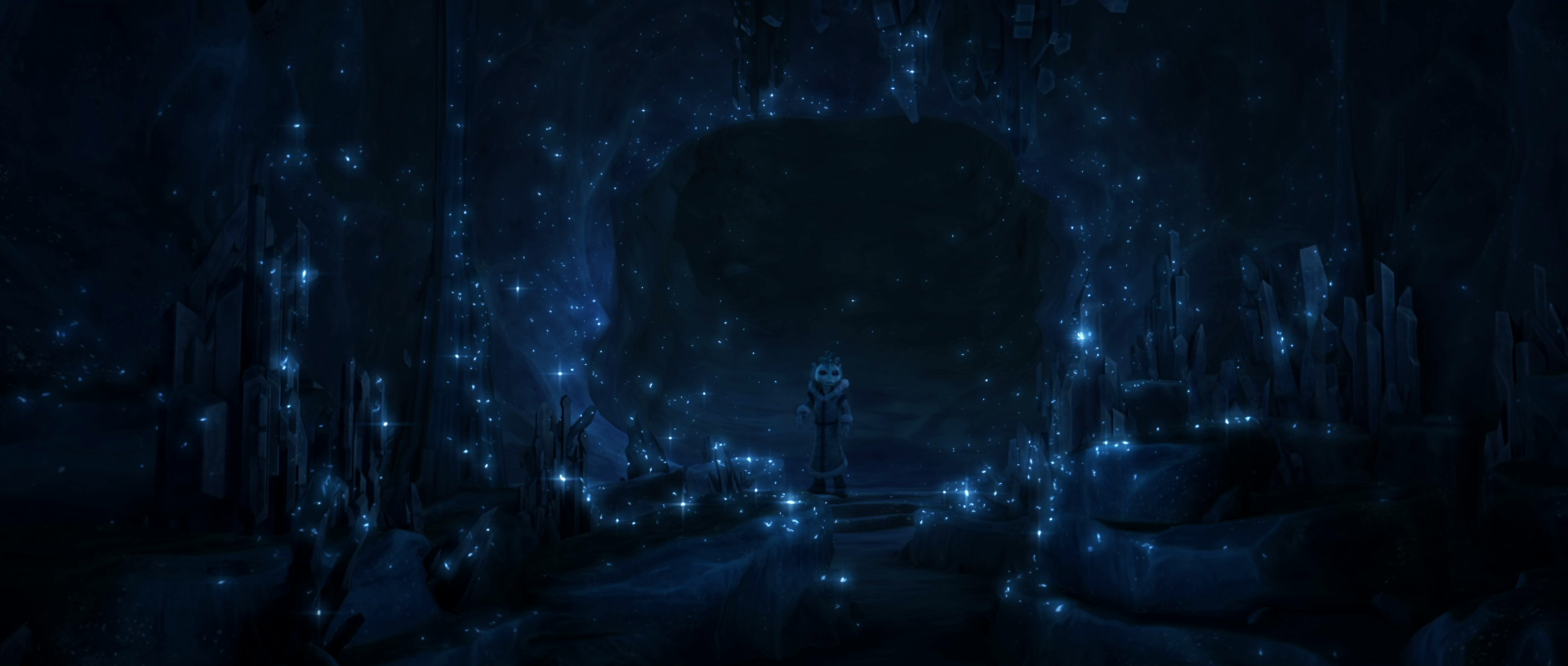
The Crystal Cave of Ilum
Kyber crystals were most notably found in Ilum's Crystal Cave. They were a critical component in the construction of lightsabers, focusing energy into the weapon's distinct plasma blade. The crystals shared a special relationship with the Jedi for tens of thousands of years, and welcomed them to hear their song and learn their lessons. Jedi younglings traveled to the ice caves to harvest their own crystals, which they then used to build their lightsabers. The Force guided their selection, finding a crystal that matched them as Jedi. To those not meant to receive it, the crystal was cold to the touch, but those the crystal chose would hear its "music" and "harmony," becoming attracted to it. Crystals lacked color before they were chosen by a Jedi. Once chosen, most lightsabers became blue or green, though other shades were created in some instances, most notably Mace Windu's purple blade, the yellow blades of the Jedi Temple Guards, the black Darksaber, and Ahsoka Tano's white lightsabers. The resulting crystal and blade color was decided through shifting to match the nature of the bonded owner. It was possible to alter the angle or frequency of kyber crystals or lightsaber blades, which allowed the colors of blades to be changed. This was done by Jedi Knight Anakin Skywalker to his former Padawan's lightsabers.
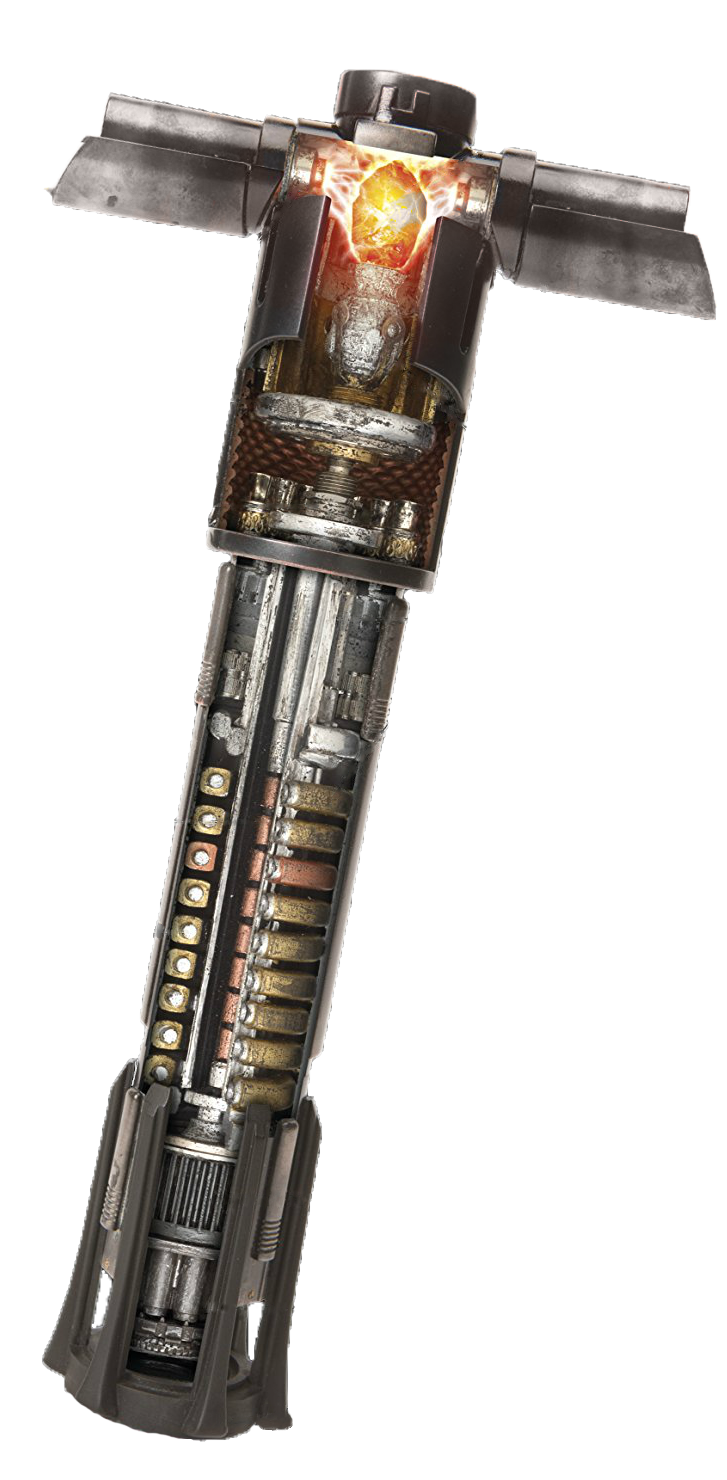
Diagram of Kylo Ren's lightsaber displaying its kyber crystal, cracked during its bleeding
Kyber crystals were inherently filled with "light side energy," and resisted any effort by dark-side practitioners to use them in lightsabers, with one crystal in particular, that belonged to the Jedi Master Kirak Infil'a, subjecting Darth Vader to intense visions. To this end, a Sith could attune to a kyber crystal only by using the Force to dominate the crystal, bending it to their will. This process caused the crystal to "bleed," as if it were a living organism, resulting in the distinctive red or crimson-bladed lightsabers synonymous with the Sith. It was possible to "heal" a corrupted kyber crystal. The information on how to heal a kyber crystal was found in the Chronicles of Brus-Bu. One instance of purifying a corrupted kyber crystal was when Ahsoka Tano purified the two crystals she retrieved from the Sixth Brother's lightsaber following his defeat. In this case, the crystals turned white.
The crystals were noted for their unmatched ability to channel energy and generate enormous returns. To this end, numerous individuals attempted to make synthetic kyber crystals, though their artificial nature made them highly unstable and explosive. If a crystal was subjected to forceful attempts to study it or harness its power, it would "flee" such attempts, hindering those that sought to use it against its will. Furthermore, those that worked in proximity to them would experience headaches and a loss of sleep, becoming incessantly fanatic and fixated over the crystal in the process.
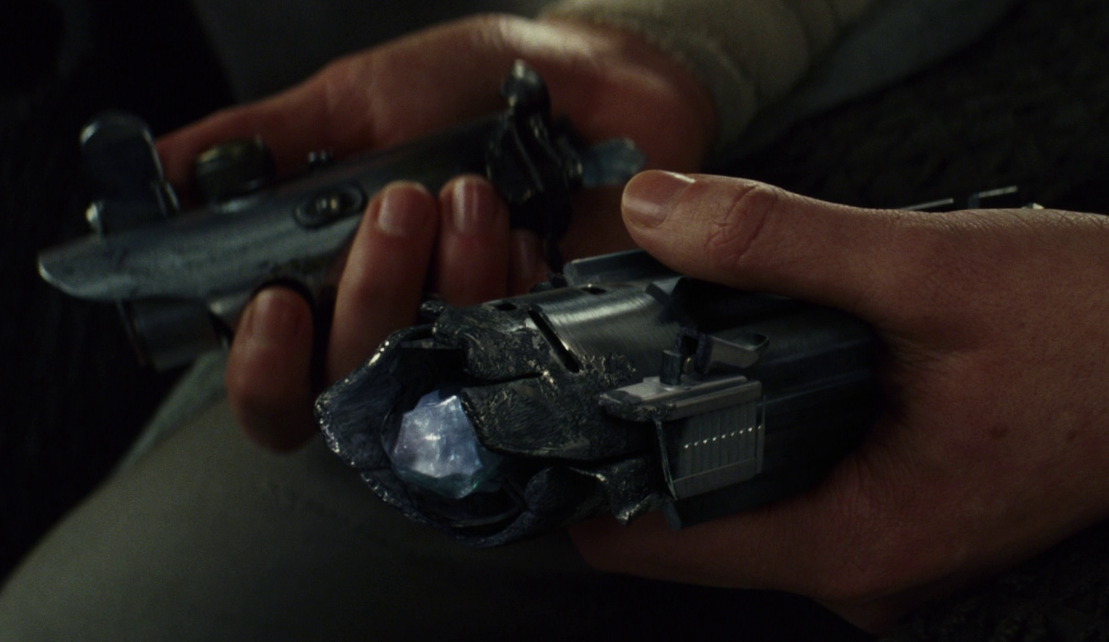
The Skywalker lightsaber was damaged by an explosion of energy that broke and exposed the crystal within.
For centuries, the Jedi cut and faceted the crystals to eliminate occlusions and intensify their power yield. Galen Erso theorized that larger crystals needed to be faceted, not only to eliminate these occlusions, but also to minimize diffraction resulting from the introduction of energy from a lasing medium. With proper faceting, the pulse of energy released by the crystal could be greatly amplified and, with the help of containment devices, or be directed into a collimating beam of incredible power, as was used on the DS-1 battle station. Galen Erso also theorized that increased energy yield could be further attained by forcing what the Jedi called the "day and night" lattices of the Force to realign. By realigning the crystals' lattices along the dark or nighttime axis of the Force, Galen postulated that it could allow for greater control over the crystal's tendency to diffract. Thus, technology could be used to force the crystals to obey their masters. The abundant yield could then be siphoned off, contained, and used as enriched energy. Without containment, the yield could result in a catastrophic event, capable of wiping out a large population center.
Specifically, when one giant kyber crystal was destabilized by Saw Gerrera, it absorbed so much energy that when it finally did reach critical mass, it exploded with enough force to destroy both the freighter transporting it and a nearby Star Destroyer.
Kyber crystals could be used to power other weapons than lightsabers. People had tried to make kyber bombs and kyber blasters, and there were a few weapons of that kind in the Jedi Archives.
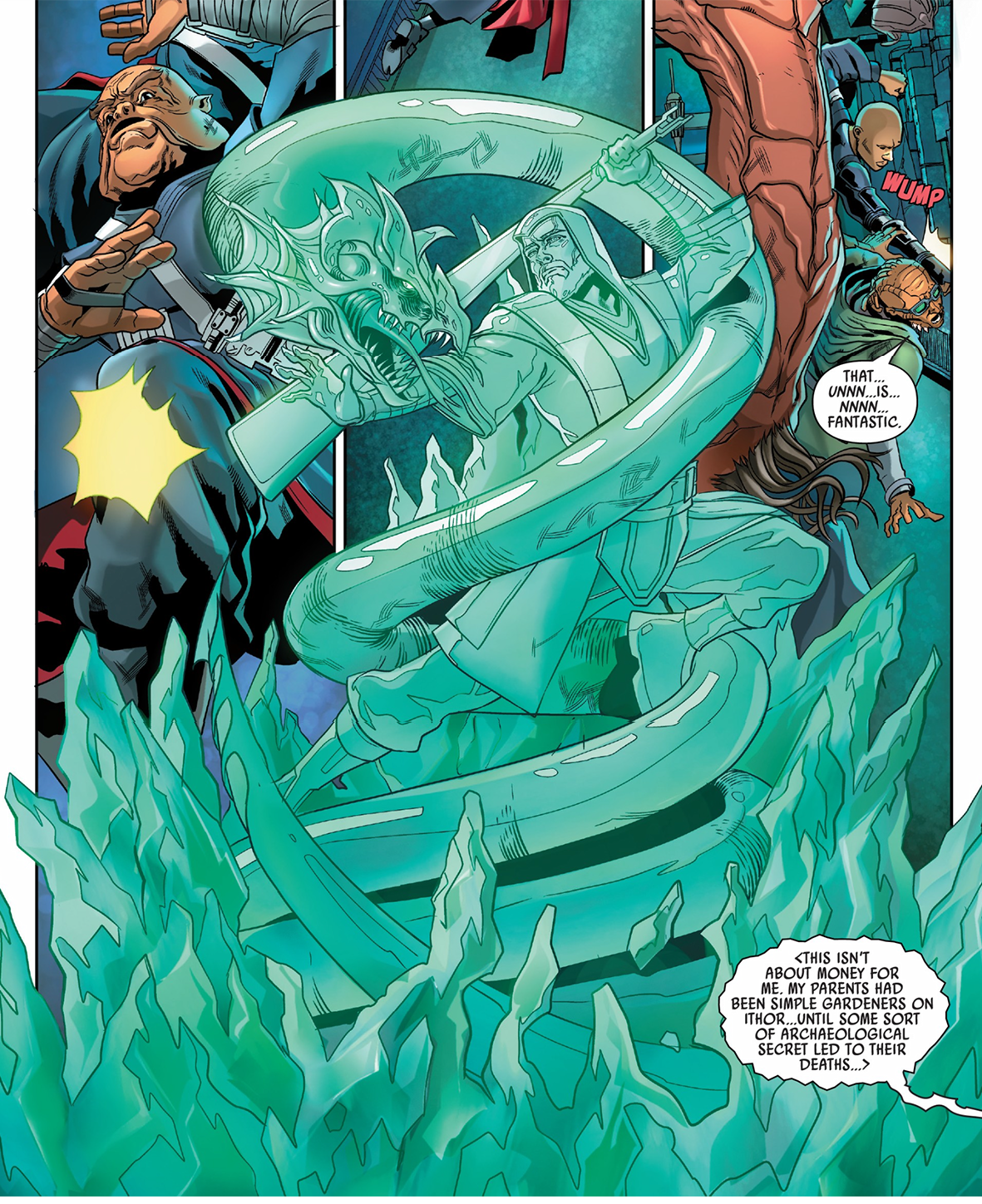
Kyber statue on Jedha
Before the Jedi and Sith orders, kyber crystals were worshiped by primitive societies for their fire-resistant properties, intricate structures, and near impermeability, signs which made them appear outwardly eternal. Ancient beings associated them with wind, rain, and breath. It is believed that the Jedi saw them as embodying an aspect of the Force. Over the centuries, the Jedi amassed an almost exclusive right to the crystals, protecting and collecting them to decorate their temples and power their lightsabers. Some saw this collection of the kybers as proof of the Jedi's inordinate greed, and their secrecy over its nature a result of their wish to remain in power. Others saw the Jedi as protecting the galaxy from those who might use the powers of the crystal for dark purposes.
Within the Temple of the Kyber on Jedha, the Jedi were able to sculpt some 2,304 statues out of kyber using lightsabers. These statues lined the tunnels of the temple and were guarded by the Guardians of the Whills. Another Kyber structure was the Kyber Arch located within one of the meditation chambers of the Jedi Temple on the Core World of Coruscant. The Arch was built out of individual Kyber crystals retrieved from the lightsabers of Jedi who had fallen in battle, becoming an advanced meditation practice that honored their sacrifice. Jedi Master Jora Malli once questioned her Padawan Reath Silas why a single Jedi could never cross the Arch alone. Silas came to realize the question was not to be taken literally, as she wanted him to see how, in order for a single Jedi to cross, the rest of the Order had needed to build the Arch and others had needed to fall in battle.
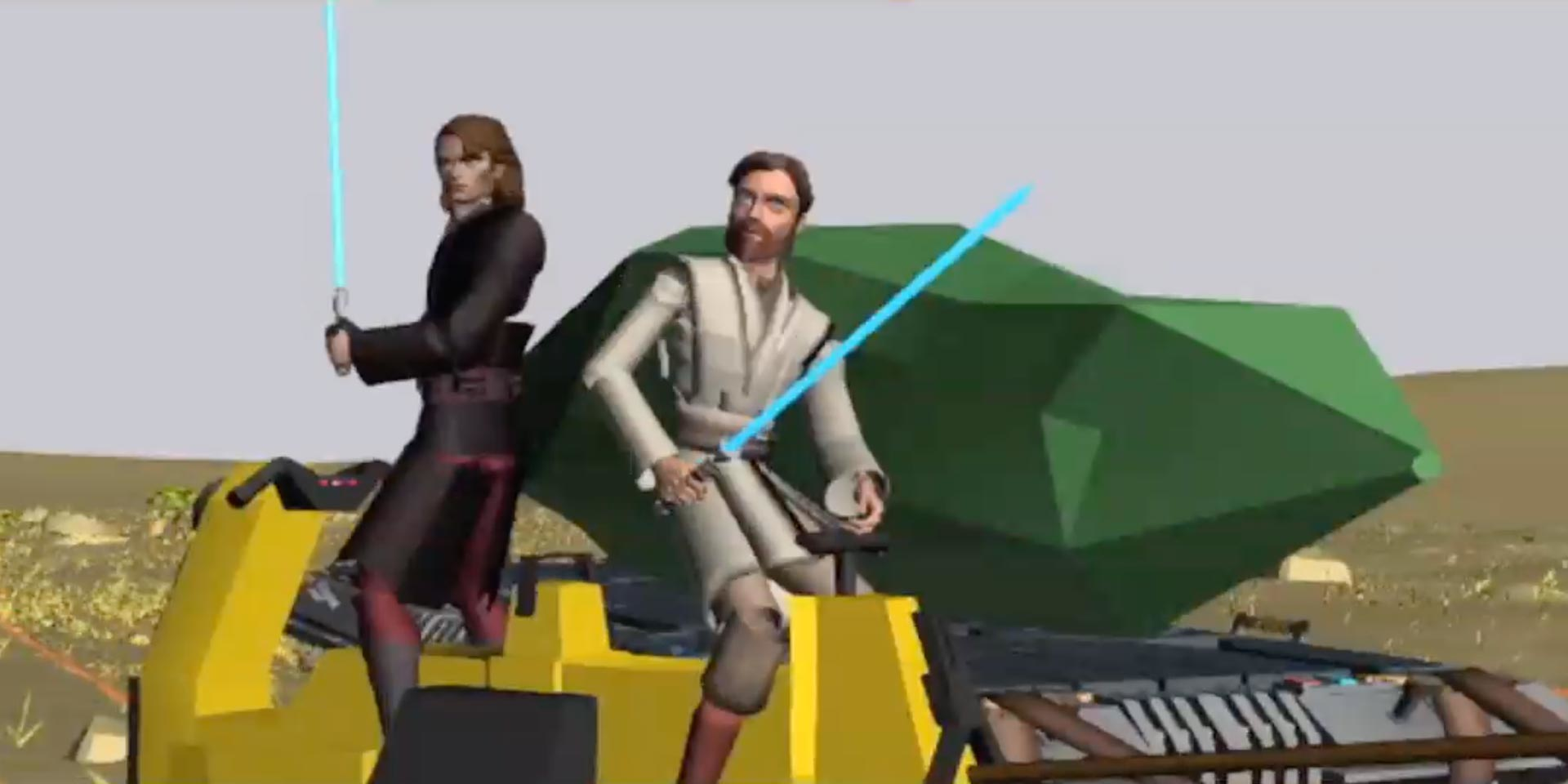
Anakin Skywalker and Obi-Wan Kenobi with a giant kyber crystal on Utapau
During ancient wars between the Jedi and the Sith, in which both sides fought for control over the galaxy, superweapons were created by the Sith that were powered by giant kyber crystals. Around 3966 BBY the Sith Lord Darth Tanis developed kyber weaponry for the Sith on Malachor. The Sith temple on the planet Malachor was one such weapon. Although these stories were considered legends, a giant kyber crystal was discovered on Utapau during the Clone Wars. The Confederacy of Independent Systems attempted to acquire the crystal, but they were discovered by Jedi Master Obi-Wan Kenobi and Jedi Knight Anakin Skywalker. The Jedi were able to prevent the crystal from falling further into Confederate hands, though Yoda was concerned that Darth Sidious would discover another giant kyber crystal in order to construct another superweapon. Doctor Istan Zaly, at least according to Adjutant General Wilhuff Tarkin, had great success in analyzing kyber crystals' internal structures.
After the fall of the Galactic Republic and the rise of the Galactic Empire, Sidious—publicly known as Emperor Palpatine—and his Empire continued the Republic's former construction of the Death Star, a battle station capable of destroying entire planets. Kyber crystals were used as part of the Death Star's superlaser, and Galen Erso was brought on as the main researcher under Project Celestial Power. Kyber crystals were looted from Jedi lightsabers, temples, Ilum, and other worlds where they could be found. To some, studying the crystals was not disrespecting the Jedi's teachings, but allowing galactic society to expose some of the Jedi's long-held secrets.
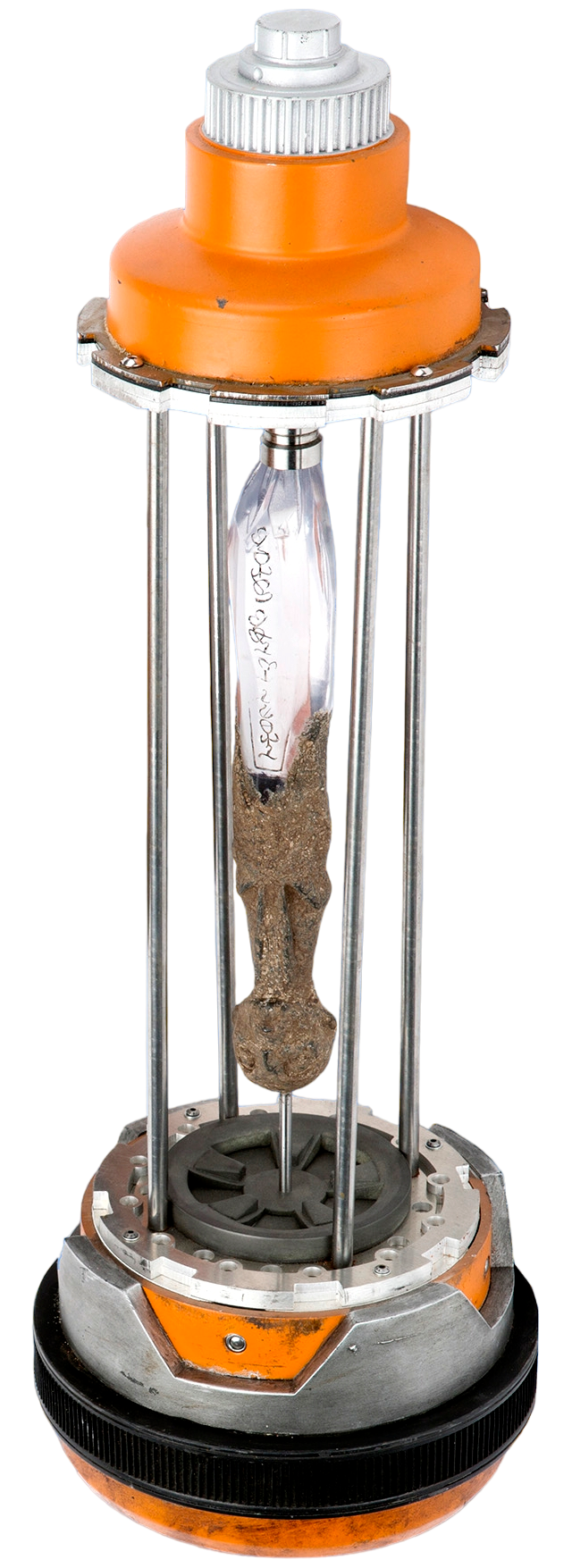
A kyber crystal used by Saw Gerrera's Partisans
In the case of Ilum, it was targeted by the Empire for its crystal deposits, creating a different state of affairs than how the Jedi had treated the planet; while the Order had seen Ilum as sacred, and a Jedi would hear the songs of the crystals, the Empire's greed for them ravaged the world, breaking crystals as they mined them out in order to twist them to their own plans. The effect of their mining could be seen from space, with former Padawan Ahsoka Tano becoming angry upon seeing all the Empire had done in their search for kyber. Tano also believed the Empire would be unable to even see the crystals. In spite of her anger, she did not attack the Imperial blockade; to get crystals for her new lightsabers, she was instead called to those inside the Sixth's Brother's blade, resulting in her defeating him and purifying the crystals. Five years before the Battle of Yavin, another crystal was located by the rebels from Lothal, who discovered its location and destroyed it. The destruction produced a large shock wave, destroying all Imperial ships in its path.
In 1 BBY, a combined Partisans and Rebel Alliance strike team led by Saw Gerrera with the help of the Jedi Ezra Bridger intercepted the Imperial cargo freighter Freighter 2716, which was transporting a giant kyber crystal to the Tonnis sector. Before the freighter could rendezvous with Captain Slavin's Star Destroyer, Saw destabilized the crystal. The resulting explosion destroyed both the freighter and Slavin's Star Destroyer. However, Saw failed to uncover the Empire's secret Death Star project.
A year after the Battle of Endor, five pilgrims from the Church of the Force—the MA-B0 cargo lifter droid Mabo, Addar the human, Jumon the Iakaru, Madrammagath the Elomin, and Uggorda the Duros—undertook a mission to return kyber crystals which the Empire had plundered from Christophsis. They had been dispatched by the pastor and philanthropist Brin Izisca. During their pilgrimage, they were attacked by several Force-sensitive creatures named the Kyaddak, which killed Maddrammagath, Uggorda, and Jumon. After thirteen arduous days, Mabo and Addar finally reached a broken crystal wall, where they returned the crystals to their excavated site.
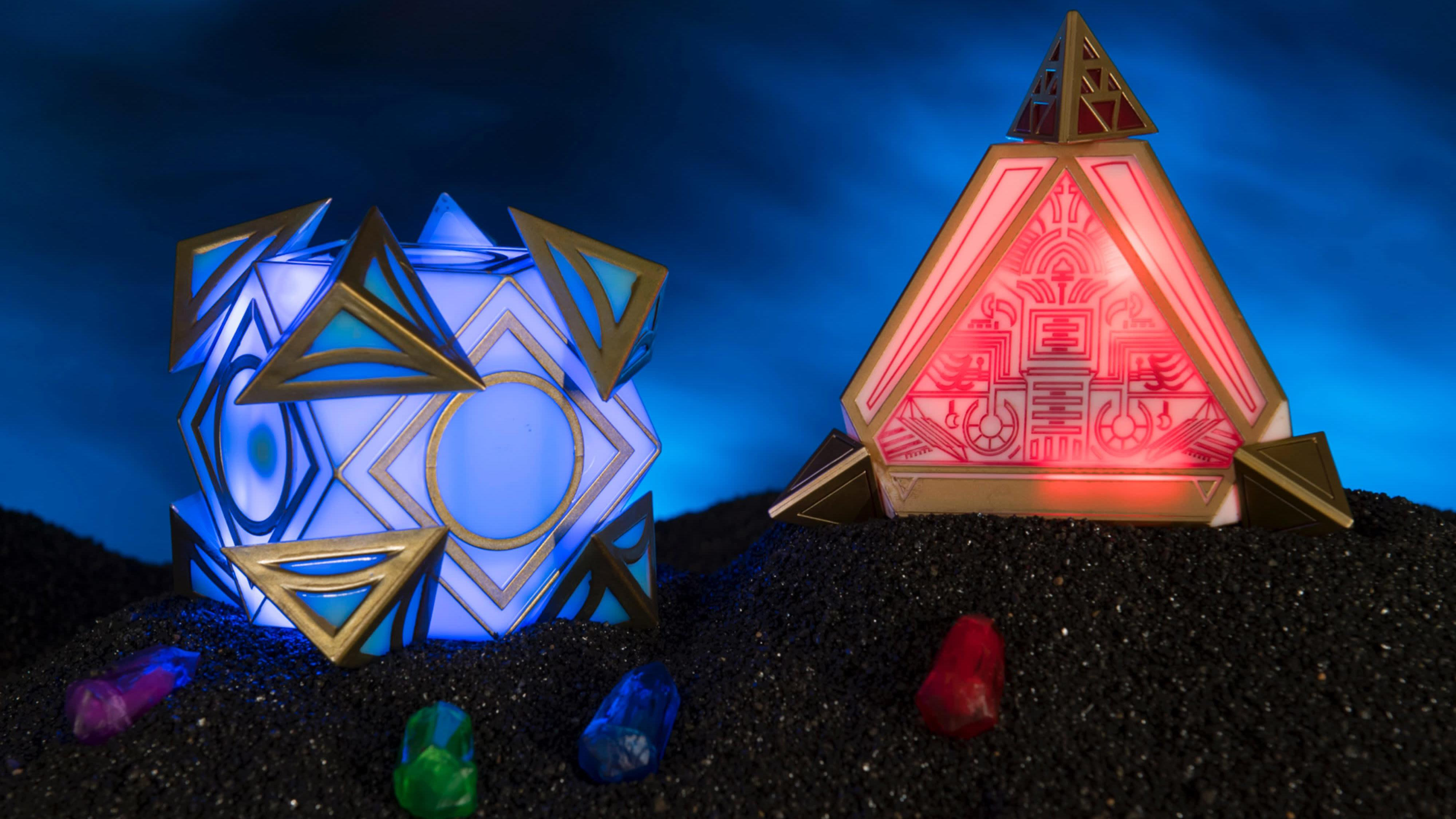
Dok-Ondar sold holocrons and kyber crystals at his Den of Antiquities.
Kylo Ren's lightsaber had a cracked kyber crystal, which generated an unstable blade. The excess power was vented out the sides, thus creating a crossguard-like design. The most important and prestigious vessels of the First Order had weapons upgraded with kyber crystals from some secret source in the Unknown Regions.
Around 34 ABY, several kyber crystals could be found at Black Spire Outpost on Batuu. The shop Dok-Ondar's Den of Antiquities sold blue, green, purple, yellow, white, and red crystals for lightsabers, and also offered larger green and red crystals as curiosities. At the same time, the Gatherers of Savi's Workshop had obtained several Imperial Era kyber crystal containers and distributed their crystals to customers who came to learn the art of lightsaber crafting.
There were different types of kyber crystals that could be used in the construction of lightsabers or in other objects. Some of them created different effects in the lightsabers which they were used in.
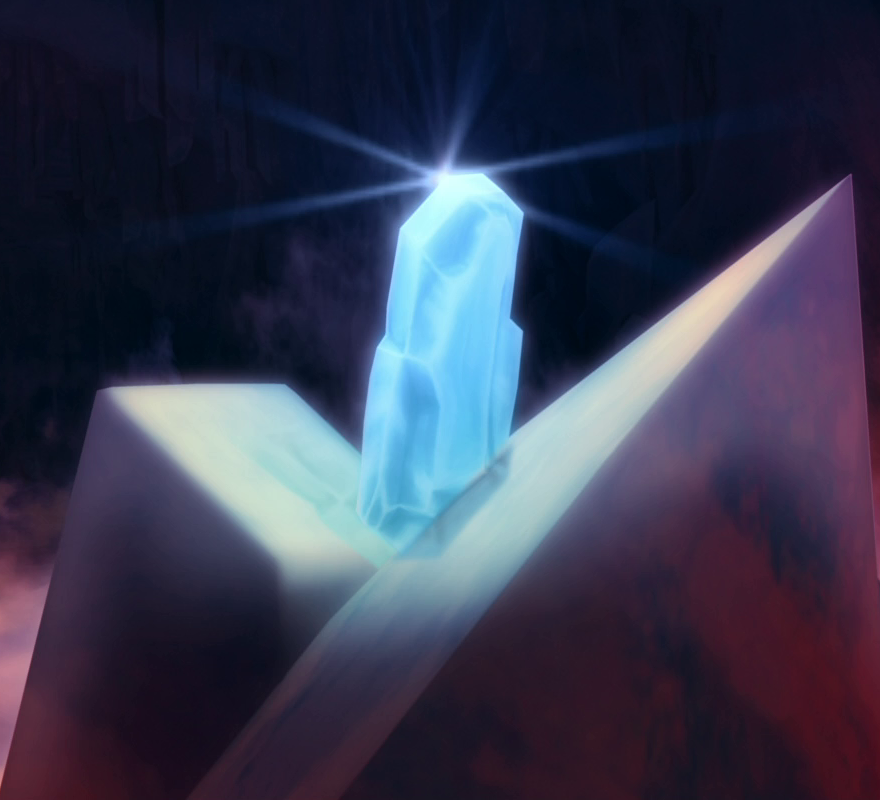
An Ilum crystal
- Adegan crystal
- Barab ingot
- Christophsis crystal
- Dantari crystal
- Dragite gem
- Ghostfire crystal
- Ilum crystal
- Jedha crystal
- Kimber stone
- Krayt dragon pearl
- Lorrdian gemstone
- Nishalorite stone
- Seeker crystal
- Solari crystal
- Sorian crystal
- Synthetic kyber crystal
- Tainted Nightsister Crystal
- Thontiin crystal
- Varpeline crystal
- Zophis crystal
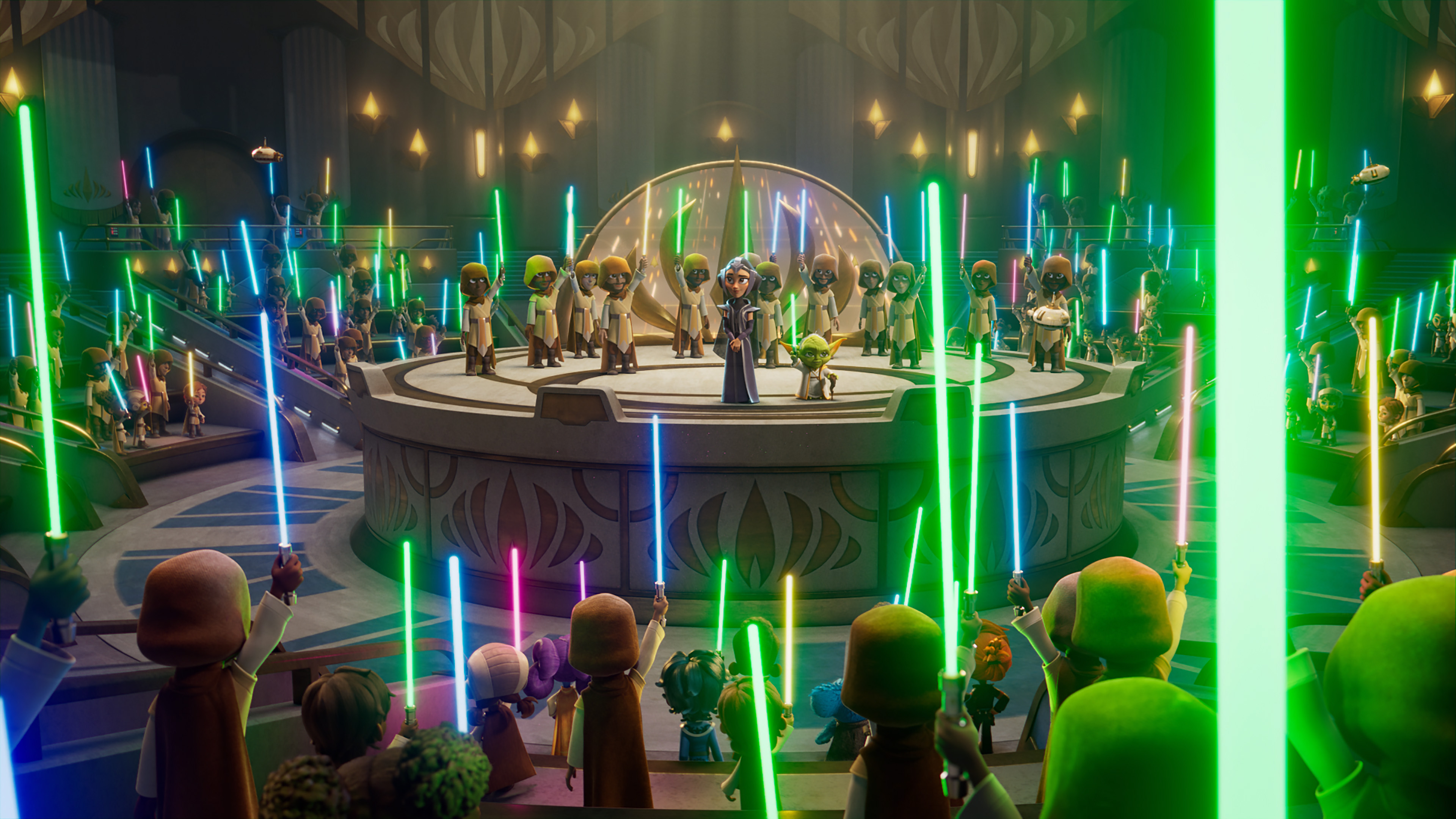
A variety of lightsaber colors existed during the High Republic Era.
- Amethyst/Purple (such as Mace Windu's lightsaber,Lys's lightsaber,Vernestra's lightsaber, and Huulik's lightsaber)
- Black (such as the Darksaber and lightsabers)
- Blue (such as Obi-Wan Kenobi's third lightsaber, the Skywalker lightsaber, and Leia's lightsaber)
- Crimson/Red (post-bleeding, such as Sith lightsabers like Darth Vader'sdual-phase lightsaber,Darth Sidious' lightsabers, and Kylo Ren's lightsaber)
- Cyan (such as )
- Green (such as Yoda'sshoto lightsaber,Luke Skywalker's green lightsaber, and Sabine Wren's lightsaber)
- Indigo (such as Vix Fonnick's lightsaber)
- Magenta (such as )
- Orange (such as Drya Thornne's lightsaber)
- Pink (seeker crystals)
- White (post-purification, such as Ahsoka Tano's white lightsabers,Komat's lightsaber, and Jora Malli's lightsaber)
- Yellow (such as the Jedi Temple Guards' lightsaber pikes,Ventress's lightsaber, and Rey's lightsaber)
The earliest concept of the kyber crystal, the "Kiber crystal", conceived as a plot device in the second draft for the film became New Hope similar to The One Ring in J. R. R. Tolkien's fantasy trilogy The Lord of the Rings. The first connection between crystals and swords appeared in one of George Lucas' initial notes for Empire Strikes Back reads "Kiber crystal in sword?". "A Test of Strength," the seventh episode from the fifth season of the animated series Star Wars: The Clone Wars, first identified kyber crystals as a component of lightsaber construction.
- The Art of Star Wars: Visions